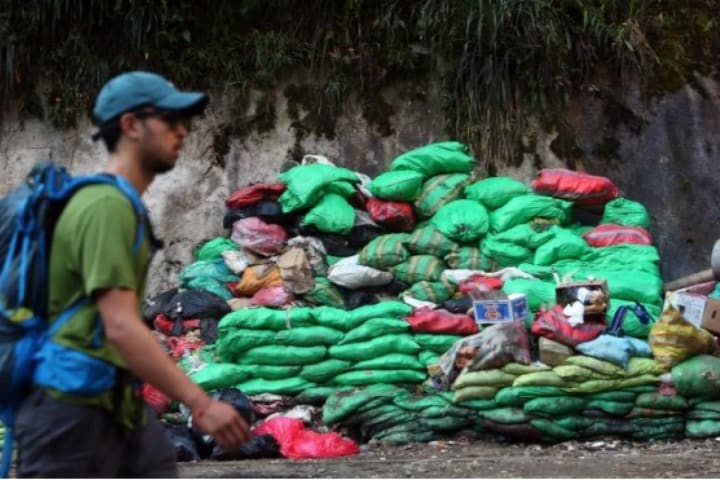Over-Tourism: An irreparable damage to Machu Picchu.
The price of being one of the most awe-inspiring and popular tourist attraction in the world, may cost the Citadel to close its doors.

Machu Picchu was built around 1450 and the magnificence of its location nestled among the slopes of the Andes-Jungle of Peru, made it listed among the 7 wonders of the world (Brodersen, 2016). After its rediscovered in 1911, for many years it preserved the natural and authentic infrastructures: no ladders, no signs, no repaired roofs and completely pathless. It remained authentic and magnificent until UNESCO declared Machu Picchu a World Heritage Site in 1983, capturing the attention of international and local stakeholders (UNESCO, 2012).

Machu Picchu: an exploded resource
Clearly the interest is to increase profits, not to preserve this wonder for next generations to continue seeing it.
Peru’s economic develop is tied to the archaeological park, given evident benefits to the country. The tourism sector has increased exponentially over the last decades, developing into a very important source of income, reaching around 9.3% of the total GDP in 2019 (World Travel & Tourism Council, 2020). The interest to keep attracting more tourists and a serious lack of regulations merged with cheap flights and big marketing campaigns, are leading to the exploitation of Machu Picchu.
The growing number of visitors over the last 10 years have been severe for Machu Picchu conservation, becoming a double-edge sword for Peru. The limits of the Citadel carrying capacity where designated - after UNESCO expressed their concerns in 2016 announcing to place the site on their endangered list – to a maximum capacity of 2,500 visitors a day (UNESCO, 2016). Despite many archaeologists and academics openly expressed their concerns in previous years on the sustainable operations of the site, the last record showed tourists keep rising to over 1.5 million in 2019, 84.72% more than 2009 (Figure 1) (MINCETUR, 2019).
Sadly, the boom of tourism over the last couple of years is a big business for authorities in charge of its protection and preservation. This maximum carrying capacity is not taking seriously, visitors exceed around 1,300 more per day (West, 2019). Authorities have not done nothing to prevent a future destruction, instead two new access routes where opened to allowed 3,300 visitors per day, above 32% suggested by the UNESCO, archeologists and academics (Matsangou, 2019).

Machu Picchu is a victim of its own success.
The environmental impacts suggest a dark future for the Citadel. In 15 years, there will be no longer a Machu Picchu.
Machu Picchu was not built to hold crowds of visitors, studies suggest Machu Picchu was a ceremony temple with less than 1000 villagers (Zan & Lusiani, 2011). Over-tourism causes exponentially foot traffic from thousands of visitors every day, eroding the fragile roads which are contained by antient architectural material. In addition, travellers are still allowed to touch some walls causing erosion, rusty surfaces and discolouration (Bouchard, Carlotto & Usselman; 1992). Unfortunately, the incessant direct contact is speeding the process of deterioration.

Additionally, crowds are becoming harder to control and manage by the tourist authorities. In January 2020, a group of tourists attempted the ruins with acts of vandalism, attacking the local heritage. The authorities discovered the group sneaked into the site at night and damaged the stone wall of Temple of the Sun by cracking a piece into the floor (Ganz, 2020). The losses are irreparable for the history of Machu Picchu.
Moreover, more tourists mean more garbage. Tourists leave 14 tons of trash every day in the nearest city and inside the citadel, this include plastics bottles that can easily end in the local river and cooking oil from more than 100 tourist hotels/restaurants in the area. Approximately, more than two thousand litters of cooking oil are poured into the river, disrupting the fragile ecosystem of the surroundings (Blazheska, 2017).

Under the pressure of UNESCO, in 2019 local authorities prepared a waste management plan to transform oil into biodiesel and implemented a plastic compacting plant which allowed to increase the recycling (“War against garbage in Machu Picchu”, 2018). Despite this initiative, garbage is still hard to control by the authorities due to the limited roads and being railway the only mode of transportation. Thus, the extra garbage needs to travel to Cusco to be treated.
A new international airport: Is the government trying to bury Machu Picchu?
With many diverse stakeholders and the lack of sustainable interests, the future of the Inca’s heritage is hostile.
Local concern rises as the government approved the project of a second International Airport in the country, located in Chinchero 30 km from Machu Picchu (Collyns, 2019). Chinchero belong to the Sacred Valley, declared Cultural Heritage of the Nation in 2006, there are several archaeological sites partially unexplored but very valued for archaeologists, historians and specialists (Dannemann, 2019). The Sacred Valley that surrounds Machu Picchu with priceless historical-cultural landscapes, now is endangered. The terminal will allow 6-8 million tourists annually, more than 40% of the current flow.

To receive such number of tourists, new infrastructure, roads and touristic services are promoted by the government with the purchase of nearby land (Matsangou, 2019). Something that will create more pollution, disorderly and uncontrolled urbanization causing unsustainable tourist attractions. Villagers, archaeologists, historians and other specialists have collected firms against the planned construction, arguing that human and cultural rights must be consider to stop further damages (Dannemann, 2019).






Comments
There are no comments for this story
Be the first to respond and start the conversation.